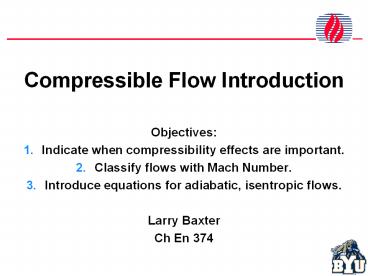Compressible Flow Introduction PowerPoint PPT Presentation
Title: Compressible Flow Introduction
1
Compressible Flow Introduction
- Objectives
- Indicate when compressibility effects are
important. - Classify flows with Mach Number.
- Introduce equations for adiabatic, isentropic
flows. - Larry Baxter
- Ch En 374
2
Flow Classifications
Flow Regime Density Gradient Shock Waves
Incompressible Negligible None
Subsonic Small None
Transonic Significant First appear
Supersonic Significant Significant
Hypersonic Dominant Dominant
3
Property Changes
For isentropic (?s0), constant-heat-capacity
conditions
4
Speed of Sound
C
C
pressure wave ?xn?
5
Speed of Sound in Materials
Most (perfect) gas conditions
High frequency waves (isothermal rather than
isentropic expansion)
Solids and liquids (actually gases as well),
where K is bulk modulus
Bulk modulus, not heat capacity ratio
6
Typical Sound Speeds (STP)
Generally, sound travels faster in solids than
liquids and faster in liquids than gases.
7
Sound Speed vs. Molecular Speed
Molecular theory of gases indicates that the
average molecular speed is
Therefore, the average velocity of a molecule
(speed in any specified direction) is
In the case of a sound wave, molecules dont have
time to adjust their temperatures to the rapid
change in pressure, so their temperature changes
slightly inside the wave. If this change is
completely adiabatic generally a good
assumption the specific heat ratio accounts for
the temperature change. Thus, the speed of sound
is identically equal to the speed at which
molecules travel in any one direction under
conditions of a propagating wave.
8
Sound Travels in Longitudinal Waves
Light, cello strings, and surfing waves are
transverse waves.
Sound travels in a longitudinal or compression
wave.
9
Ideal and Perfect Gases
Ideal Gas
Good approximation for most conditions far from
critical points and at atmospheric pressure or
lower.
Perfect Gas
Reasonable approximation for many gases.
Generally also assume that the gas is
non-dissociating.
10
Gas Flows
Perfect Gas
11
Mach-Number Relations
Isentropic Expansion
Isentropic Expansion
12
Graphical Representation
13
Critical Properties
0.8333 for k 1.4 (air)
0.9129 for k 1.4 (air)
0.5283 for k 1.4 (air)
0.6339 for k 1.4 (air)
14
Blunt Body Flows
Ma 2.2
15
Sonic Flows
Ma 1.7
Ma 3.0
16
Compressible Flow Essentials
- Know what a Mach number is and the regimes of
flow as indicated by the Mach number. (Mach
number is ratio of velocity to the speed of sound
at the same conditions. Mach numbers of 0.3, 0.8,
1.2, and 3 separate incompressible, subsonic,
transonic, supersonic, and hypersonic regimes,
respectively). - Know how pressure, temperature, density, and
velocity change across a normal shock wave.
(First three all increase in direction of
decreasing velocity, with pressure increasing the
most. Velocity decreases from supersonic to
subsonic value, with post-shock velocity
decreasing as pre-shock velocity increases).
17
Supersonic vs. Subsonic Flows
18
Area Changes Differ with Ma
19
Critical Area
20
Mass Flow Relationships
Choked flow
All flows
21
Normal Shock Wave
22
Shock Waves
23
Normal Shock Wave
24
Nozzle Performance
25
Compressible Flow Essentials
- Be able to explain on a molecular level the
origin of the changes in pressure, temperature
and density. (Molecules collide into one another
or a surface, exchanging kinetic energy for
pressure or temperature. Ideal gas law still
applies to give relationship between density,
pressure, and temperature). - Know how streamlining designs differ for
compressible flows compared to incompressible
flows. (Leading edges are relatively sharp edges
rather than rounded corners and heat dissipation
is a major issue).
26
Three Classes of CFD
- Finite Difference
- Original and still widely used formulation for
CFD describes flow fields as values of velocity
vectors at discrete points. - Finite Volume
- Close cousin to finite difference, but discrete
points represent average values of velocities in
a volume rather than at a point.
- Finite Element
- Most commonly used for heat transfer and stress
calculations in solid bodies rather than fluid
mechanics (because of stability issues). - Much easier to describe general/complex
geometries than FD/FV techniques. - Solves for dependent variable (velocity,
temperature, stress) with variations across
element by minimizing an objective function
27
First Derivative FD Formulas
central O(?x2)
backward O(?x)
forward O(?x)
backward O(?x2)
forward O(?x2)
28
First Derivative FV Formulas
General Formula
central O(?x2)
backward O(?x)
forward O(?x)
backward O(?x2)
forward O(?x2)
29
Second Derivative FD Formulas
central O(?x2)
backward O(?x)
forward O(?x)
30
First Derivative FV Formulas
General Formula
central O(?x2)
backward O(?x)
forward O(?x)
31
Navier-Stokes Cartesian Coord.
x component
y component
z component
32
Outline of CFD model
33
Stoker Geometry and Surface Areas
Super heater 2 194 m2 / 2090 ft2
Super heater 1 364 m2 / 3920 ft2
Boiler
Boiler Bank 1181 m2 / 12700 ft2
Super heater 1
Super heater 2
Economizer 330 m2 / 3550 ft2
Econo.
y
Secondary air
8 kg/s, 175 ºC
Secondary air
x
8 kg/s, 175 ºC
z
Spreader stokers
Grate air
9 kg fuel/s
24 kg/s, 175 ºC
34
Computational mesh
35
Cloud (Particle) Trajectories
36
Oxygen Mass Fraction Contours
37
Velocity and Heat Release Vary
38
Initial Deposition Rates Vary
39
Temporal Deposition Variation
40
Gas Temperature Field
41
CFD Essentials
- Know the distinguishing characteristics of finite
difference, finite volume, and finite element
approaches to numerical methods differ. - Know where to find (in these notes) common
algebraic approximations for first and second
derivatives for FD and FV approaches and the
accuracy of the approximation. - Know (conceptually) how the algebraic
approximations are substituted into the partial
differential equations and how these are then
solved. - Recognize that entire careers are dedicated to
small fractions of CFD problem solving because of
issues of convergence, stability, non-uniform
grids, turbulence, etc.

